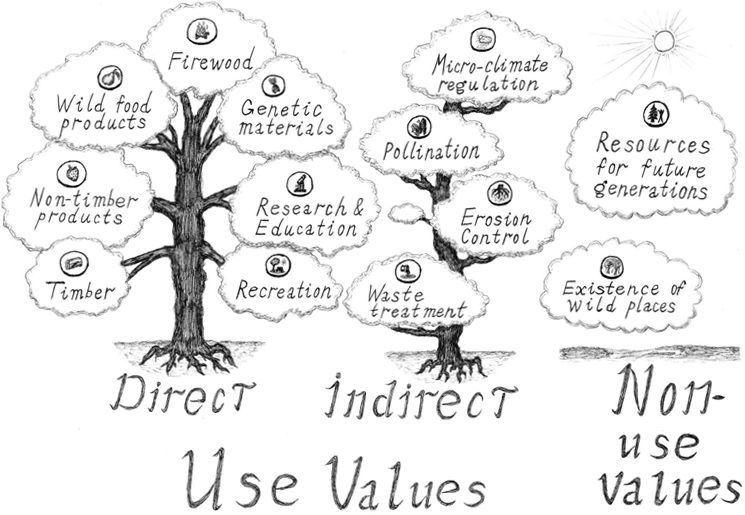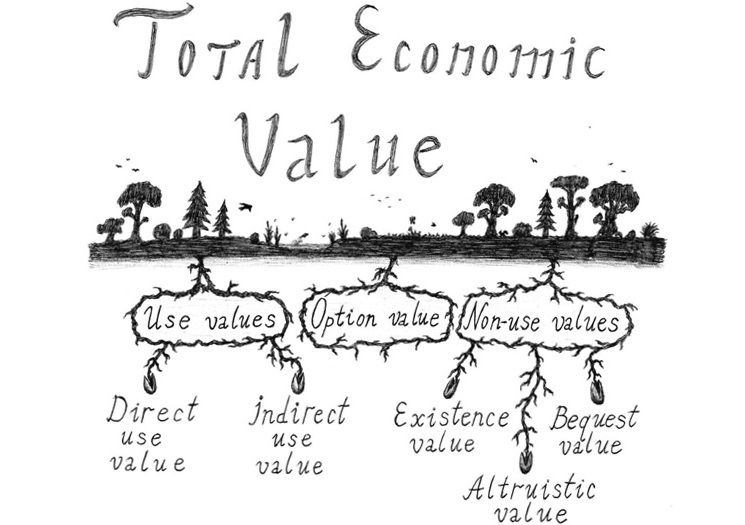
Total Economic Value of Forest Ecosystems
Welcome back, dear Friend! In the last training, we saw what the ecosystem services are, what this concept is, and how we can consider them and understand them in relation to forest management.
We also saw that ecosystem services are split into four main categories. These are provisioning, regulating, cultural, and supporting services. And we saw some of the examples of these four categories of ecosystem services in the forest.
Finally, we also understood that while some benefits and values of ecosystem services can be direct and observable, others are rather indirect and not really observable and noticeable. This, in fact, reflects how we use, manage, and benefit from forest ecosystem services.
To start with, I can use the benefits of the forest around me directly. I can pick up mushrooms and berries and cook and eat them. I can go here and pick up flowers for my girlfriend. I can actually take my girlfriend to the forest to have a nice romantic walk among the woods.
These, in fact, are the direct use values of the forest ecosystem services. Why? Because each one of us can easily count, for example, how many mushrooms I picked at the forest, how many times I took my girlfriend for a walk in the woods, and so on.
Therefore, these economic, social, and environmental benefits of the forest are easily quantifiable and can easily be considered in decision-making and forest ecosystem management. And, as you recall the categories of ecosystem services, they relate mostly to the provisioning and cultural services.
Certainly, I also benefit from the forest indirectly. For example, the berries I pick, the mushrooms and flowers we collect with my girlfriend are the result of many not-so-obvious functions and processes in the forest. One of them being the pollination by insects.
For example, if I had an orchard or a garden near the forest, I would benefit from the pollination service of this forest due to the increasing of yields of my fruits and vegetables.
Also, the water that I can drink from the stream nearby, the fresh air that I breathe, and the microclimate that I enjoy here are the “products” of water, soil, and air purification services, as well as of the service of regulating the climate here. All these benefits that people receive indirectly from the forest scientists call indirect use values. And they are connected to the regulating ecosystem services.
Both direct use and indirect use benefits from the forest are also relevant to me in the future. For example, I would love this forest to be preserved in order for me to be able to always come back here and to enjoy its benefits (direct and indirect) and so on. I also would like this forest to be useful for me for a long period of time and to have the option to use it again and again. This is what scientists term option value of ecosystem services. In fact, all direct use, indirect use, and option values are grouped into the use values of the forest ecosystem services. But there are also non-use values of the forest, which are not easily observable and quantifiable.
Non-use values are the values, when people appreciate the mere existence of a forest and its biodiversity without actually using them either directly or indirectly, either now or in the future.
For example, the mere presence of this forest, even though I am not coming here and using it, can be of value to me. I can attach certain values to and actually be willing to pay for the preservation of this forest. This is what scientists term existence value. And it is connected to the supporting ecosystem services in that these ecosystem services support the existence of the habitat for biodiversity here and of all the forest around me.
Besides appreciating the existence of the forest for myself, I may also care about the existence of the forest for and its use by other people. For example, I may really care about the farmers, who benefit from the ecosystem services of this forest that stands near their farms and orchards. Thus, for example, the pollination service is spilled over the local farms and orchards. In fact, I am being altruistic in my sharing of the value of the forest. And this is what scientists term as altruistic value.
Finally, I may be concerned not only for people nearby or other people that are using the forest, but also for future generations, many generations ahead of me that would be using this forest and benefitting from it. So, I may be interested in protecting and conserving this forest, so that future generations are able to benefit and use it as well. This is what scientists call bequest value. And it may relate to all ecosystem services extended into the future.

Figure 1. Different values provided to people by forest ecosystems.
All these use and non-use values now and in the future are comprised in the concept called Total Economic Value of an ecosystem and its services. Total Economic Value is a convenient framework to sum up and demonstrate all the benefits and values that a forest ecosystem can bring to people and how valuable a forest can be.
This can be a valuable input and a useful tool for decision-making, land use planning, and environmental policies that the decision makers can consider and use.

Figure 2. Components of the Total Economic Value framework.
But, indeed, how can we use this Total Economic Value to protect and manage our forest sustainably? Let us explore this question.
Among the variety of direct use, indirect use, and non-use values, we can account for and consider mostly the ones that we can observe. For example, we can clearly observe how many mushrooms or berries I picked, how many trees I cut and sold on the market, and how much profit I gained from this bargain. In fact, these ecosystem services can have a real and quantifiable price on the markets and therefore can be accounted for in decision-making. In contrast, the non-market benefits and non-market ecosystem services do not have such a price and therefore cannot be easily quantified.
This discrepancy makes the decision makers and forest users to prioritize the consumptive and extractive uses of the forest. Therefore, they go for the cut, sell, and earn quick profit. Certainly, this situation leads to overconsumption of natural resources, depletion of the resources in the forest, and degradation of the forest ecosystem. In the long term, everyone loses.
However, when we consider the indirect use and even non-use values of the forest, the story takes a more optimistic turn. Now, we can demonstrate the entire value of the forest in short-term perspective and in long-term perspective, inform our stakeholders about this Total Economic Value, and therefore communicate the importance of conserving and managing the forest sustainably for the long use and benefit from its ecosystem services. This is what the Total Economic Value can really help us to do.
The concept of Total Economic Value can also help us to see what we are losing if we are overusing, over-extracting, and overconsuming resources and services in the forest. In this way, the Total Economic Value appeals to the basics of human psychology: the more we know about the potential losses that we may incur, the more we are willing to protect this value and this forest that we value and the more chances we have of getting stakeholders onto our side of sustainable forest management.
However, now you may be asking, “So, how can we account for the values in the Total Economic Value that do not have market prices attached to them and that do not have real markets? And how can we demonstrate these values to stakeholders and engage them into sustainable forest management?” These are very good questions that we will explore in the next training. See you there!
DISQUS COMMENTS WILL BE SHOWN ONLY WHEN YOUR SITE IS ONLINE